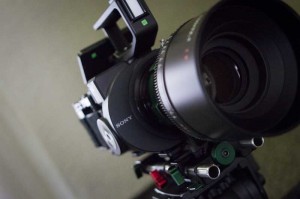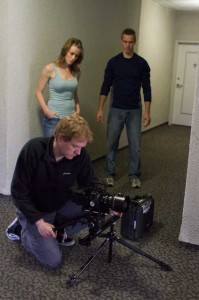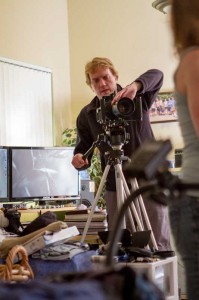
It has recently become a common desire to have things that go fast appear to go very slowly, and until quite recently, the only way to achieve the effect was to throw a lot of money at the problem.
It has been quite some time since it was commonplace to shoot 35mm film for high-speed work. Photosonics cameras, which shot a couple thousand frames a second, would go through a third of a 400-foot roll just getting up to speed. Even then, though, there weren’t many who could afford it. The first electronic cameras capable of the appropriate frame rates were oriented toward scientific research, test engineering and machine vision. And they were frequently in black-and-white. Companies like Redlake and Vision Research eventually came out with color versions that were quickly snapped up by a film industry eager to avoid the two-takes-a-roll issue of high-speed 35mm, even though those early color cameras were more at home in a test lab than a studio. Frankly, though, it still isn’t exactly cheap. Costs to take out a Vision Research Phantom Gold for a day can approach half the purchase value of something like a Sony FS700 body.
For quite a long time, filmmakers on non-Hollywood budgets who wanted anything more than 60 frames per second were stuck with the impressive, if still somewhat imperfect, software solutions like Twixtor. And while Twixtor is great at making already-slow things even slower, the world is full of people desperately rotoscoping away, having recently discovered that it’s much trickier to go from 60 fps to 120 fps than it is to go from 120 fps to 240 fps.

Thus it was that I was quite excited when Illya Friedman from Hot Rod Cameras told me he had a pre-release version of the new Sony FS700 available for me and director Daniel Scherlto play with for a day. The camera I saw was not final, with a particular note about noise performance, although the software seemed reasonably comprehensive and it only crashed once.
Attentive readers will have realized that I’m quite excited about the high frame rate abilities of the FS700, and I don’t think that’s unreasonable. Obviously, it’s not very useful to compare it directly to some of Vision Research’s products, but the availability of something at this price is a considerable advance on the availability of absolutely nothing. A good portion of the furore over the Panasonic HVX-200 is related to the fact that it was one of the first, if not the first—camera to do 60 frames per second, albeit at 720P, at a price less than a Varicam.
So, what is it? Well, basically, it’s an FS100 that will shoot for something like 1800 frames at 240fps, equivalent to a 10-times slowdown on 24P material that runs just under 1.2 minutes at that rate, or about eight seconds of real time. It will, on paper, go faster than that, but I found the increase in noise and softness became objectionable above 240fps. Other people have considered the 480 usable, but it is undeniably of lower resolution than the camera’s 1080P output at normal frame rates. The high end of high speed, Phantoms with Cinemags, will shoot hundreds of frames a second until the mag is full, so the limitation is the amount of high speed buffer that is available in the camera.
This buffer needs to be seriously quick in order to buffer the frames as they’re shot. Sony claims it has a 4K sensor, and they’re presumably storing raw sensor data, so as not to have to de-Bayer it at high speed. Given those assumptions, at 240fps it will be somewhat over two gigabytes per second. The sort of memory used in desktop PCs is capable of accommodating this, and the FS700 presumably has more than 16 GB of it, if my ballpark calculations are anywhere near correct. Anyone who has used any sort of high-speed camera – even the novelty-value features in some extant handycams – will be aware of this buffering behavior, which the FS700 is more or less technologically bound to replicate. On the other hand, I may be slightly unfair in comparing it to devices that cost 20 or 30 times as much money.

Other than the standout high-speed feature, it is a perfectly serviceable production camera – effectively an FS100 with some useful new gamma curves and a welcome filter wheel. There is also a 3Gb SDI port, making better off-board recording more convenient. This is particularly important, as, like the FS100 and F3, I cannot help but think the onboard recording is the weak point of the camera, as a whole. On high-speed material, with statistically smaller per-frame changes, VLC reports the bit rate of shots recorded to SD card as barely 20 Mbps, less than a very average DSLR. Even with the very best encoder in the world – which is something that exists only in large, power-hungry rack-mounted equipment – that is not enough. This camera is better than 20 megabits a second. The other question this raises is what to do about recording high-speed material, which is played out of the camera’s buffer at the end of a shot. If the camera implements deck control over SDI and all the stars are otherwise in alignment, recording of high-speed material could be automated. However, I would be the first to cautiously test with my recorder of choice before making any assumptions.
Also, it would not be unreasonable to expect improved imaging performance and lower noise from what is being billed as a new 4K sensor downsampled to 1080p. While I have not shot a side-by-side comparison, I cannot say that any increase in sharpness or lack of noise was particularly obvious, but again, this was pre-release firmware with potential caveats around noise performance.. Likewise, I am not entirely convinced by the upcoming 4K-over-SDI firmware upgrade. This will create a situation rather like the one that exists with the Canon C300 and C500, where the C500 provides access to all the data from the same sensor as the 300. The C300 is an excellent camera with very low noise pictures, but it remains to be seen whether a full-resolution debayer of a given sensor really contains any more information – noise and demosaic artifacts notwithstanding – than a 1080P scaled version.
I have not shot all the tests I would like to shoot, but the fairly obvious conclusion is that this camera is of significant interest to anyone in the mood for cheap high speed, which alone is enough to ensure its success. Beyond that, it is an FS100, which is already a very successful camera, and it is soon to be a 4K camera. I’m not sure what other boxes it is expected to tick. I do wonder what affect it will have on people like Vision Research, though. The answer would doubtlessly be that they make high-grade bespoke hardware, catering to the high end, and they are not worried.
On the other hand, that’s what Da Vinci always said.
The Courier from Daniel Scherl on Vimeo.





